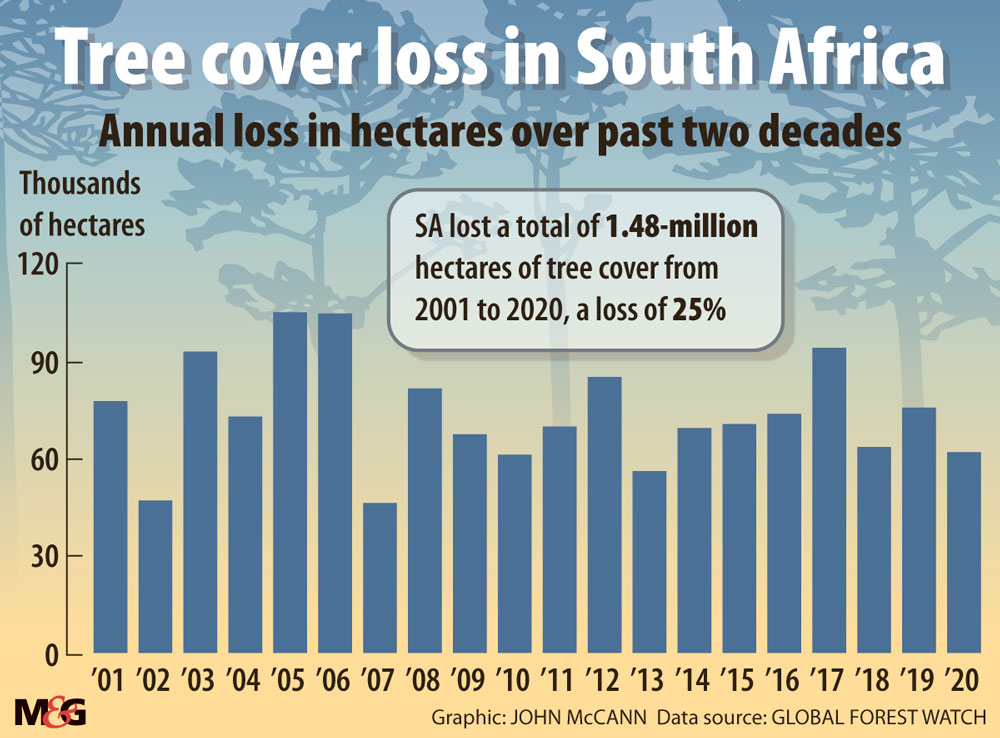Johannesburg City Parks and Zoo teams collecting trees for planting
South Africa is counting on its tree cover to act as a protected carbon sink that will further drop emissions accelerating climate change.
The policy move is in line with international climate commitments and a 2018 warning from leading scientists that forests are a major requisite in the global fight against catastrophic climate change, thanks to their unparalleled capacity to absorb and store carbon.
The Intergovernmental Panel on Climate Change says that stopping deforestation and restoring damaged forests could provide up to 30% of the climate solution.
Boost to mitigation efforts
South Africa’s land cover is dominated by open ecosystems in the form of shrublands (covering just less than 40% of the total land area), savanna woodlands (33%) and grasslands (27%).
Both indigenous and exotic forest plantations make up the remainder, with indigenous forests occupying less than 0.3% of South Africa’s land area, according to GeoTerraImage, while exotic forest plantations occupy about 1% of the overall area.
Data on tree cover loss in relation to its climate significance focuses on loss of humid tropical primary forests because of their high carbon stocks. Findings in the Global Forest Watch show that from 2001 to 2020, South Africa lost 1.48-million hectares of tree cover, equivalent to a 25% decrease in tree cover since 2000, and 517Mt of CO₂ emissions.
The global status is more gloomy showing that primary rainforest destruction increased by 12% from 2019 to 2020. Back home, forest cover is relatively small but government’s key climate policies such as the Low Emissions Development Strategy and the UN aligned, REDD+ plan (reducing emissions from deforestation and forest degradation in developing countries) see tropical primary forests as an important mechanism for mitigating climate change by locking carbon in those locations.
Tax and trees
Trees are described as sinks within the carbon cycle that absorb, accumulate and sequester CO₂ from the atmosphere. Carbon sequestration by plantations and harvested wood products as a climate change mitigation option is included in the Carbon Tax Bill.
Commenting on the policy development, the Paper Manufacturers Association said that sequestration by trees in carbon tax calculations and small afforestation as an offset both play vital roles in mitigating climate change.
Paper manufacturers are important stakeholders in sequestration due to their reliance on plantations, which have their own unique role in sequestration. According to audit firm Deloitte, a large discrepancy in carbon storage potential presents an opportunity for more carbon sequestration projects in South Africa.
The analysis cites research that found the carbon storage potential of Johannesburg is unequally distributed as a result of unequal tree cover with areas having very few trees and subsequently low carbon storage.
To illustrate this inequality, the paper said that in areas with higher density tree coverage there was about 1 500 tonnes of CO₂ stored per square kilometre, while in lower density areas there was only about 50 tonnes of CO₂ per square kilometre.
 (John McCann/M&G)
(John McCann/M&G)
Conflicting local views
Increasingly, South African scientists are discouraging African governments from towing the Global North’s line that recommends mass tree planting exercises to address climate change.
A number of them argue in the science journal, Trends in Ecology and Evolution, (first cited in New Frame) that mass tree planting campaigns are based on “wrong assumptions”, adding in another paper that there is a profound misreading of Africa’s grassy biomes (savannas).
The authors, including renowned ecologist William Bond, argue that these initiatives distract global attention from the tougher business of decarbonising the world where it matters more, adding that tree planting initiatives also ignore the people living and living off Africa’s vast savannas.
Bond and his colleagues found that even if Africa achieved the 100 million hectare target, current carbon growth rates would be mitigated by a mere 2.7% per year while land use would increase substantially to achieve this.
The researchers said that the international misinterpretation driving these initiatives was based on the notion that Africa’s savannas are considered “deforested” without consideration that grasslands existed, alongside forests, for millions of years before humans began felling trees.
Tunicia Phillips is an Adamela Trust climate and economic justice reporting fellow, funded by the Open Society Foundation for South Africa